Combined Chemical Modification of Bamboo Material Prepared Using Vinyl Acetate and Methyl Methacrylate: Dimensional Stability, Chemical Structure, and Dynamic Mechanical Properties
Abstract
1. Introduction
2. Materials and Methods
2.1. Materials
2.2. Bamboo Acetylation Pretreatment
2.3. In Situ Polymerization of MMA on Bamboo
2.4. Characterization of Raw and Pretreated Bamboo
2.5. Dimensional Stability Analysis of Raw and Pretreated Bamboo
2.6. Dynamic Mechanical Analysis of Raw and Pretreated Bamboo
3. Results
3.1. Weight Gain Rate, Volume Bulking Efficiency, and Conversion Rate
3.2. Morphology Characterization
3.3. FTIR Analysis
3.4. Dimensional Stability
3.5. Wettability Analysis
3.6. TG Analysis
3.7. Dynamic Mechanical Analysis
4. Conclusions
Author Contributions
Funding
Conflicts of Interest
References
- Yeasmin, L.; Ali, M.N.; Gantait, S.; Chakraborty, S. Bamboo: An overview on its genetic diversity and characterization. 3 Biotech 2015, 5, 1–11. [Google Scholar] [CrossRef] [PubMed]
- Archila, H.; Kaminski, S.; Trujillo, D.; Zea Escamilla, E.; Harries, K.A. Bamboo reinforced concrete: A critical review. Mater. Struct. 2018, 51, 102. [Google Scholar] [CrossRef]
- Bekhta, P.; Niemz, P. Effect of high temperature on the change in color, dimensional stability and mechanical properties of spruce wood. Holzforschung 2003, 57, 539–546. [Google Scholar] [CrossRef]
- Hakkou, M.; Pétrissans, M.; Zoulalian, A.; Gérardin, P. Investigation of wood wettability changes during heat treatment on the basis of chemical analysis. Polym. Degrad. Stab. 2005, 89, 1–5. [Google Scholar] [CrossRef]
- Rowell, R.M.; Ibach, R.E.; McSweeny, J.; Nilsson, T. Understanding decay resistance, dimensional stability and strength changes in heat-treated and acetylated wood. Wood Mater. Sci. Eng. 2009, 4, 14–22. [Google Scholar] [CrossRef]
- He, Z.; Qu, L.; Wang, Z.; Qian, J.; Yi, S. Effects of zinc chloride–silicone oil treatment on wood dimensional stability, chemical components, thermal decomposition and its mechanism. Sci. Rep. 2019, 9, 1601. [Google Scholar] [CrossRef] [PubMed]
- Bhaskar, J.; Haq, S.; Yadaw, S.B. Evaluation and testing of mechanical properties of wood plastic composite. J. Thermoplast. Compos. Mater. 2011, 25, 391–401. [Google Scholar] [CrossRef]
- Krehula, L.K.; Katančić, Z.; Siročić, A.P.; Hrnjak-Murgić, Z. Weathering of high-density polyethylene-wood plastic composites. J. Wood Chem. Technol. 2013, 34, 39–54. [Google Scholar] [CrossRef]
- Seki, M.; Tanaka, S.; Miki, T.; Shigematsu, I.; Kanayama, K. Forward extrusion of bulk wood containing polymethylmethacrylate: Effect of polymer content and die angle on the flow characteristics. J. Mater. Process. Technol. 2017, 239, 140–146. [Google Scholar] [CrossRef]
- Hung, K.-C.; Wu, T.-L.; Chen, Y.-L.; Wu, J.-H. Assessing the effect of wood acetylation on mechanical properties and extended creep behavior of wood/recycled-polypropylene composites. Constr. Build. Mater. 2016, 108, 139–145. [Google Scholar] [CrossRef]
- Kumar, S. Chemical modification of wood. Wood Fiber Sci. 2007, 26, 270–280. [Google Scholar]
- Kurimoto, Y.; Sasaki, S. Preparation of acetylated wood meal and polypropylene composites ii: Mechanical properties and dimensional stability of the composites. J. Wood Sci. 2013, 59, 216–220. [Google Scholar] [CrossRef]
- Rowell, R.M. 14 chemical modification of wood. In Handbook of Wood Chemistry and Wood Composites; CRC Press: Boca Raton, FL, USA, 2005; pp. 381–413. [Google Scholar]
- Xie, Y.; Krause, A.; Militz, H.; Turkulin, H.; Richter, K.; Mai, C. Effect of treatments with 1,3-dimethylol-4,5-dihydroxy-ethyleneurea (dmdheu) on the tensile properties of wood. Holzforschung 2007, 61, 43–50. [Google Scholar] [CrossRef]
- Xie, Y.; Xiao, Z.; Grüneberg, T.; Militz, H.; Hill, C.A.S.; Steuernagel, L.; Mai, C. Effects of chemical modification of wood particles with glutaraldehyde and 1,3-dimethylol-4,5-dihydroxyethyleneurea on properties of the resulting polypropylene composites. Compos. Sci. Technol. 2010, 70, 2003–2011. [Google Scholar] [CrossRef]
- Jiang, T.; Gao, H.; Sun, J.; Xie, Y.; Li, X. Impact of dmdheu resin treatment on the mechanical properties of poplar. Polym. Polym. Compos. 2014, 22, 669–674. [Google Scholar] [CrossRef]
- Rowell, R.M.; Simonson, R.; Hess, S.; Plackett, D.V.; Cronshaw, D.; Dunningham, E. Acetyl distribution in acetylated whole wood and reactivity of isolated wood cell-wall components to acetic anhydride. Wood Fiber Sci. 2007, 26, 11–18. [Google Scholar]
- Obataya, E.; Furuta, Y.; Gril, J. Dynamic viscoelastic properties of wood acetylated with acetic anhydride solution of glucose pentaacetate. J. Wood Sci. 2003, 49, 152–157. [Google Scholar] [CrossRef]
- Kumari, R.; Ito, H.; Takatani, M.; Uchiyama, M.; Okamoto, T. Fundamental studies on wood/cellulose-plastic composites: Effects of composition and cellulose dimension on the properties of cellulose/pp composite. J. Wood Sci. 2007, 53, 470–480. [Google Scholar] [CrossRef]
- Li, J.; Zhang, L.-P.; Peng, F.; Bian, J.; Yuan, T.-Q.; Xu, F.; Sun, R.-C. Microwave-assisted solvent-free acetylation of cellulose with acetic anhydride in the presence of iodine as a catalyst. Molecules 2009, 14, 3551–3566. [Google Scholar] [CrossRef]
- Huang, X.; Kocaefe, D.; Kocaefe, Y.; Pichette, A. Combined effect of acetylation and heat treatment on the physical, mechanical and biological behavior of jack pine (pinus banksiana) wood. Eur. J. Wood Wood Prod. 2017, 76, 525–540. [Google Scholar] [CrossRef]
- Hill, C.A.S.; Jones, D.; Strickland, G.; Cetin, N.S. Kinetic and mechanistic aspects of the acetylation of wood with acetic anhydride. Holzforschung 1998, 52, 623–629. [Google Scholar] [CrossRef]
- Jebrane, M.; Sèbe, G. A novel simple route to wood acetylation by transesterification with vinyl acetate. Holzforschung 2007, 61, 143–147. [Google Scholar] [CrossRef]
- Huang, S.; Ma, Z.; Nie, Y.; Lu, F.; Ma, L. Comparative study of the performance of acetylated bamboo with different catalysts. BioResources 2018, 14, 44–58. [Google Scholar]
- Li, J.-Z.; Furuno, T.; Katoh, S.; Uehara, T. Chemical modification of wood by anhydrides without solvents or catalysts. J. Wood Sci. 2000, 46, 215–221. [Google Scholar] [CrossRef]
- Hill, C. Modifying the properties of wood. In Wood Modification: Chemical, Thermal and Other Processes; Wiley: Hoboken, NJ, USA, 2006; pp. 19–44. [Google Scholar]
- Çetin, N.S.; Özmen, N.; Birinci, E. Acetylation of wood with various catalysts. J. Wood Chem. Technol. 2011, 31, 142–153. [Google Scholar] [CrossRef]
- Jebrane, M.; Harper, D.; Labbé, N.; Sèbe, G. Comparative determination of the grafting distribution and viscoelastic properties of wood blocks acetylated by vinyl acetate or acetic anhydride. Carbohydr. Polym. 2011, 84, 1314–1320. [Google Scholar] [CrossRef]
- Jebrane, M.; Pichavant, F.; Sèbe, G. A comparative study on the acetylation of wood by reaction with vinyl acetate and acetic anhydride. Carbohydr. Polym. 2011, 83, 339–345. [Google Scholar] [CrossRef]
- Özmen, N.; Çetin, N.S.; Mengeloğlu, F.; Birinci, E.; Karakuş, K. Effect of wood acetylation with vinyl acetate and acetic anhydride on the properties of wood-plastic composites. BioResources 2013, 8, 753–767. [Google Scholar] [CrossRef]
- Huang, J.; Schols, H.A.; Jin, Z.; Sulmann, E.; Voragen, A.G. Characterization of differently sized granule fractions of yellow pea, cowpea and chickpea starches after modification with acetic anhydride and vinyl acetate. Carbohydr. Polym. 2007, 67, 11–20. [Google Scholar] [CrossRef]
- Cetin, N.S.; Tingaut, P.; Özmen, N.; Henry, N.; Harper, D.; Dadmun, M.; Sebe, G. Acetylation of cellulose nanowhiskers with vinyl acetate under moderate conditions. Macromol. Biosci. 2009, 9, 997–1003. [Google Scholar] [CrossRef] [PubMed]
- YongFeng, L.; XiaoYing, D.; ZeGuang, L.; WanDa, J.; YiXing, L. Effect of polymer in situ synthesized from methyl methacrylate and styrene on the morphology, thermal behavior, and durability of wood. J. Appl. Polym. Sci. 2013, 128, 13–20. [Google Scholar] [CrossRef]
- Ghorbani, M.; Nikkhah Shahmirzadi, A.; Amininasab, S.M. Physical and morphological properties of combined treated wood polymer composites by maleic anhydride and methyl methacrylate. J. Wood Chem. Technol. 2017, 37, 443–450. [Google Scholar] [CrossRef]
- Yildiz, Ü.C.; Yildiz, S.; Gezer, E.D. Mechanical properties and decay resistance of wood–polymer composites prepared from fast growing species in turkey. Bioresour. Technol. 2005, 96, 1003–1011. [Google Scholar] [CrossRef] [PubMed]
- Zhang, Y.; Zhang, S.Y.; Yang, D.Q.; Wan, H. Dimensional stability of wood–polymer composites. J. Appl. Polym. Sci. 2006, 102, 5085–5094. [Google Scholar] [CrossRef]
- Mattos, B.D.; de Cademartori, P.H.; Missio, A.L.; Gatto, D.A.; Magalhães, W.L. Wood-polymer composites prepared by free radical in situ polymerization of methacrylate monomers into fast-growing pinewood. Wood Sci. Technol. 2015, 49, 1281–1294. [Google Scholar] [CrossRef]
- Shang, L.; Jiang, Z.; Tian, G.; Ma, J.; Yang, S. Effect of modification with methyl methacrylate on the mechanical properties of plectocomia kerrana rattan. Bioresources 2016, 11, 2071–2082. [Google Scholar] [CrossRef][Green Version]
- Fu, Y.; Li, G.; Yu, H.; Liu, Y. Hydrophobic modification of wood via surface-initiated arget atrp of mma. Appl. Surf. Sci. 2012, 258, 2529–2533. [Google Scholar] [CrossRef]
- Yu, F.; Yang, W.; Song, J.; Wu, Q.; Chen, L. Investigation on hydrophobic modification of bamboo flour surface by means of atom transfer radical polymerization method. Wood Sci. Technol. 2013, 48, 289–299. [Google Scholar] [CrossRef]
- Li, Y.F.; Liu, Y.X.; Wang, X.M.; Wu, Q.L.; Yu, H.P.; Li, J. Wood–polymer composites prepared by the in situ polymerization of monomers within wood. J. Appl. Polym. Sci. 2011, 119, 3207–3216. [Google Scholar] [CrossRef]
- Stolf, D.O.; Bertolini, M.d.S.; Christoforo, A.L.; Panzera, T.H.; Ribeiro Filho, S.L.M.; Lahr, F.A.R. Pinus caribaeavar. Hondurensis wood impregnated with methyl methacrylate. J. Mater. Civ. Eng. 2017, 29, 05016004. [Google Scholar] [CrossRef]
- Li, Y.; Wu, Q.; Li, J.; Liu, Y.; Wang, X.-M.; Liu, Z. Improvement of dimensional stability of wood via combination treatment: Swelling with maleic anhydride and grafting with glycidyl methacrylate and methyl methacrylate. Holzforschung 2012, 66, 59–66. [Google Scholar] [CrossRef]
- Ma, Z.; Wang, J.; Li, C.; Yang, Y.; Liu, X.; Zhao, C.; Chen, D. New sight on the lignin torrefaction pretreatment: Relevance between the evolution of chemical structure and the properties of torrefied gaseous, liquid, and solid products. Bioresour. Technol. 2019, 288, 121528. [Google Scholar] [CrossRef] [PubMed]
- Ma, Z.; Chen, D.; Gu, J.; Bao, B.; Zhang, Q. Determination of pyrolysis characteristics and kinetics of palm kernel shell using tga–ftir and model-free integral methods. Energy Convers. Manag. 2015, 89, 251–259. [Google Scholar] [CrossRef]
- Chen, D.; Wang, Y.; Liu, Y.; Cen, K.; Cao, X.; Ma, Z.; Li, Y. Comparative study on the pyrolysis behaviors of rice straw under different washing pretreatments of water, acid solution, and aqueous phase bio-oil by using tg-ftir and py-gc/ms. Fuel 2019, 252, 1–9. [Google Scholar] [CrossRef]
- Ma, Z.; Zhang, Y.; Li, C.; Yang, Y.; Zhang, W.; Zhao, C.; Wang, S. N-doping of biomass by ammonia (nh3) torrefaction pretreatment for the production of renewable n-containing chemicals by fast pyrolysis. Bioresour. Technol. 2019, 292, 122034. [Google Scholar] [CrossRef] [PubMed]
- Zeng, Y.; Yang, X.; Yu, H.; Zhang, X.; Ma, F. The delignification effects of white-rot fungal pretreatment on thermal characteristics of moso bamboo. Bioresour. Technol. 2012, 114, 437–442. [Google Scholar] [CrossRef] [PubMed]
- Nuopponen, M.H.; Birch, G.M.; Sykes, R.J.; Lee, S.J.; Stewart, D. Estimation of wood density and chemical composition by means of diffuse reflectance mid-infrared fourier transform (drift-mir) spectroscopy. J. Agric. Food Chem. 2006, 54, 34–40. [Google Scholar] [CrossRef] [PubMed]
- Weiland, J.-J.; Guyonnet, R. Study of chemical modifications and fungi degradation of thermally modified wood using drift spectroscopy. Holz Als Roh-Und Werkst. 2003, 61, 216–220. [Google Scholar] [CrossRef]
- Ye, X.; Wang, H.; Wu, Z.; Zhou, H.; Tian, X. The functional features and interface design of wood/polypropylene composites based on microencapsulated wood particles via adopting in situ emulsion polymerization. Polym. Compos. 2018, 39, 427–436. [Google Scholar] [CrossRef]
- Xu, J.; Zhang, Y.; Shen, Y.; Li, C.; Wang, Y.; Ma, Z.; Sun, W. New perspective on wood thermal modification: Relevance between the evolution of chemical structure and physical-mechanical properties, and online analysis of release of vocs. Polymers 2019, 11, 1145. [Google Scholar] [CrossRef]
- Nystrom, D.; Lindqvist, J.; Ostmark, E.; Antoni, P.; Carlmark, A.; Hult, A.; Malmstrom, E. Superhydrophobic and self-cleaning bio-fiber surfaces via atrp and subsequent postfunctionalization. ACS Appl. Mater. Interfaces 2009, 1, 816–823. [Google Scholar] [CrossRef]
- Chen, Y.; Liu, B.; Yang, H.; Wang, X.; Zhang, X.; Chen, H. Generalized two-dimensional correlation infrared spectroscopy to reveal the mechanisms of lignocellulosic biomass pyrolysis. Proc. Combust. Inst. 2019, 37, 3013–3021. [Google Scholar] [CrossRef]
- Ma, Z.; Zhang, Y.; Shen, Y.; Wang, J.; Yang, Y.; Zhang, W.; Wang, S. Oxygen migration characteristics during bamboo torrefaction process based on the properties of torrefied solid, gaseous, and liquid products. Biomass Bioenergy 2019, 128, 105300. [Google Scholar] [CrossRef]
- Ma, Z.; Wang, J.; Zhou, H.; Zhang, Y.; Yang, Y.; Liu, X.; Ye, J.; Chen, D.; Wang, S. Relationship of thermal degradation behavior and chemical structure of lignin isolated from palm kernel shell under different process severities. Fuel Process. Technol. 2018, 181, 142–156. [Google Scholar] [CrossRef]
- Das, M.; Chakraborty, D. Influence of mercerization on the dynamic mechanical properties of bamboo, a natural lignocellulosic composite. Ind. Eng. Chem. Res. 2006, 45, 6489–6492. [Google Scholar] [CrossRef]
- Su, C.; Zong, D.; Xu, L.; Zhang, C. Dynamic mechanical properties of semi-interpenetrating polymer network-based on nitrile rubber and poly (methyl methacrylate-co-butyl acrylate). J. Appl. Polym. Sci. 2014, 131, 40217. [Google Scholar] [CrossRef]
- Jiang, J.; Lu, J. Dynamic viscoelastic behavior of wood under drying conditions. Front. For. China 2009, 4, 374–379. [Google Scholar] [CrossRef]
- Hristov, V.; Vasileva, S. Dynamic mechanical and thermal properties of modified poly (propylene) wood fiber composites. Macromol. Mater. Eng. 2003, 288, 798–806. [Google Scholar] [CrossRef]
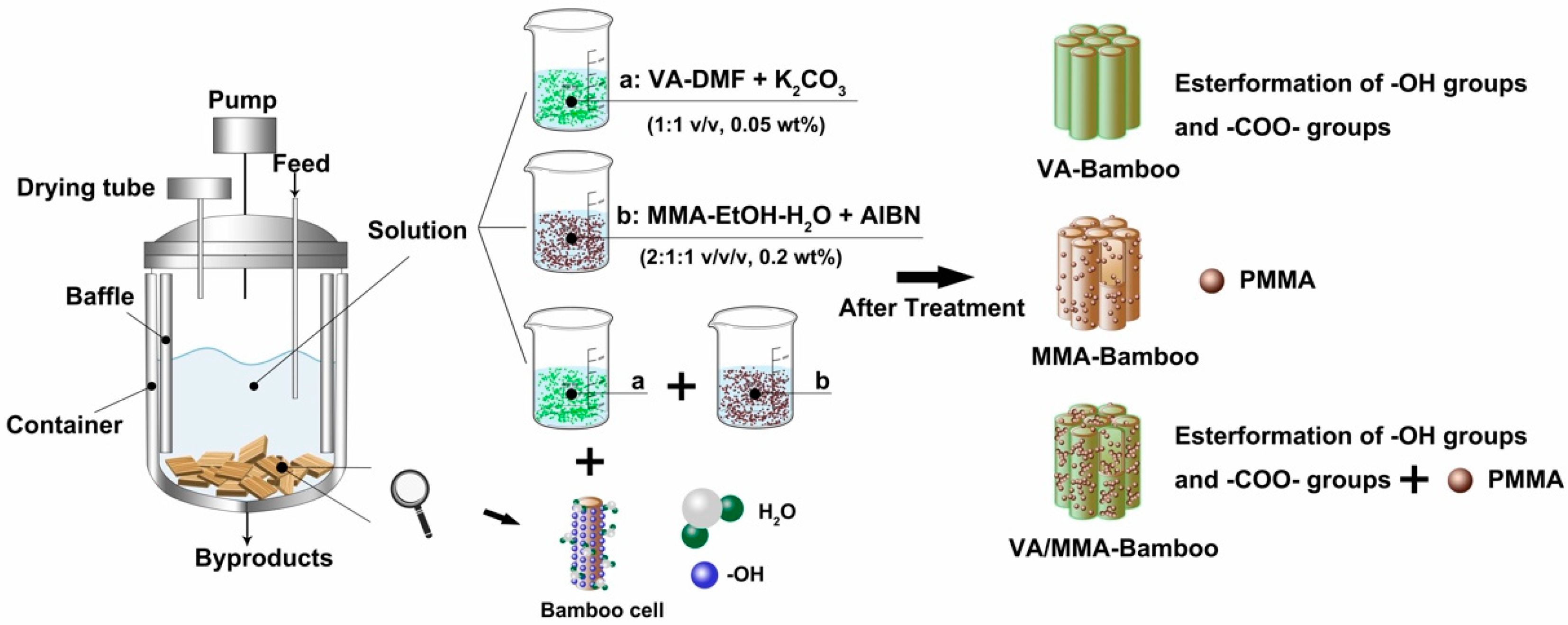


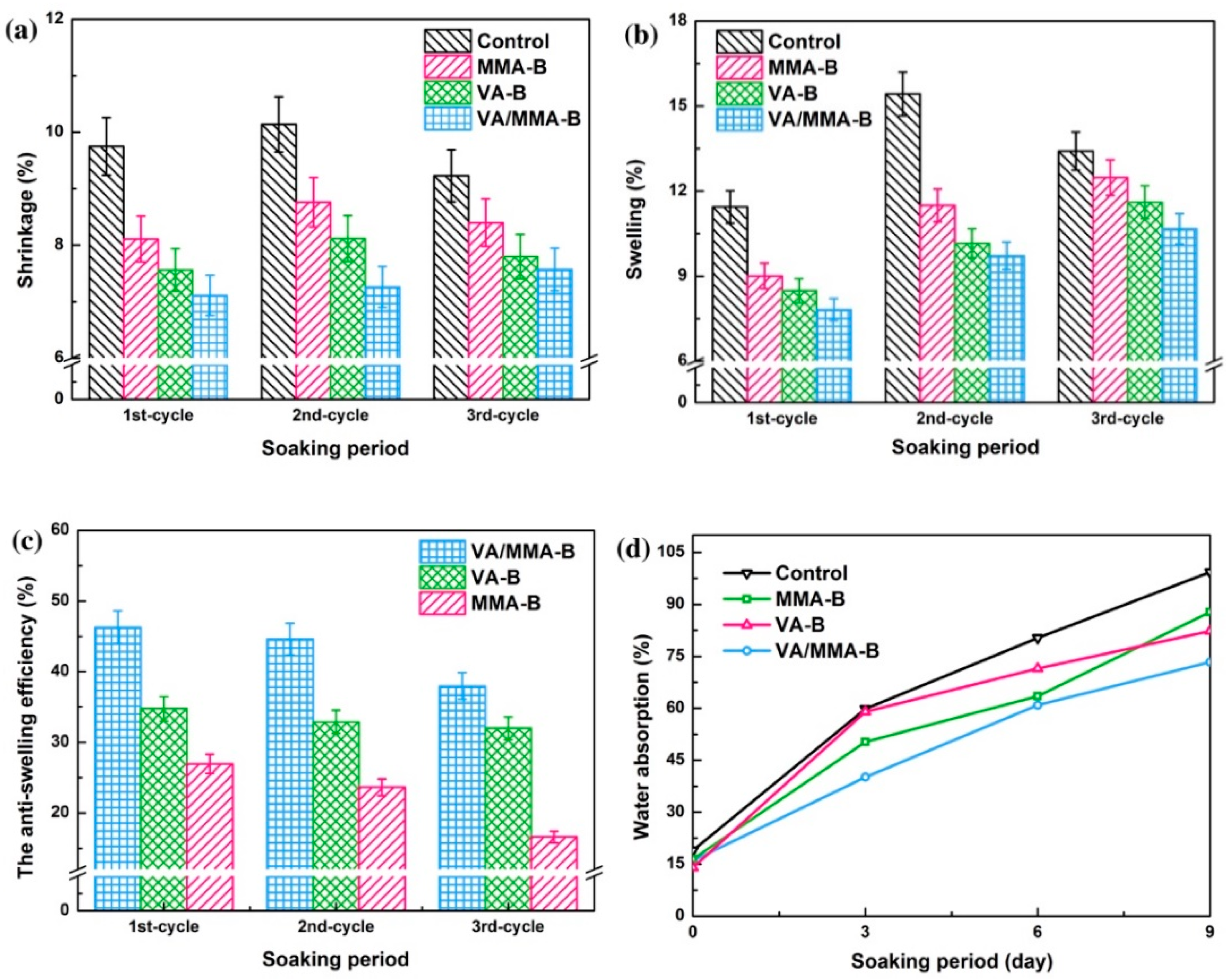
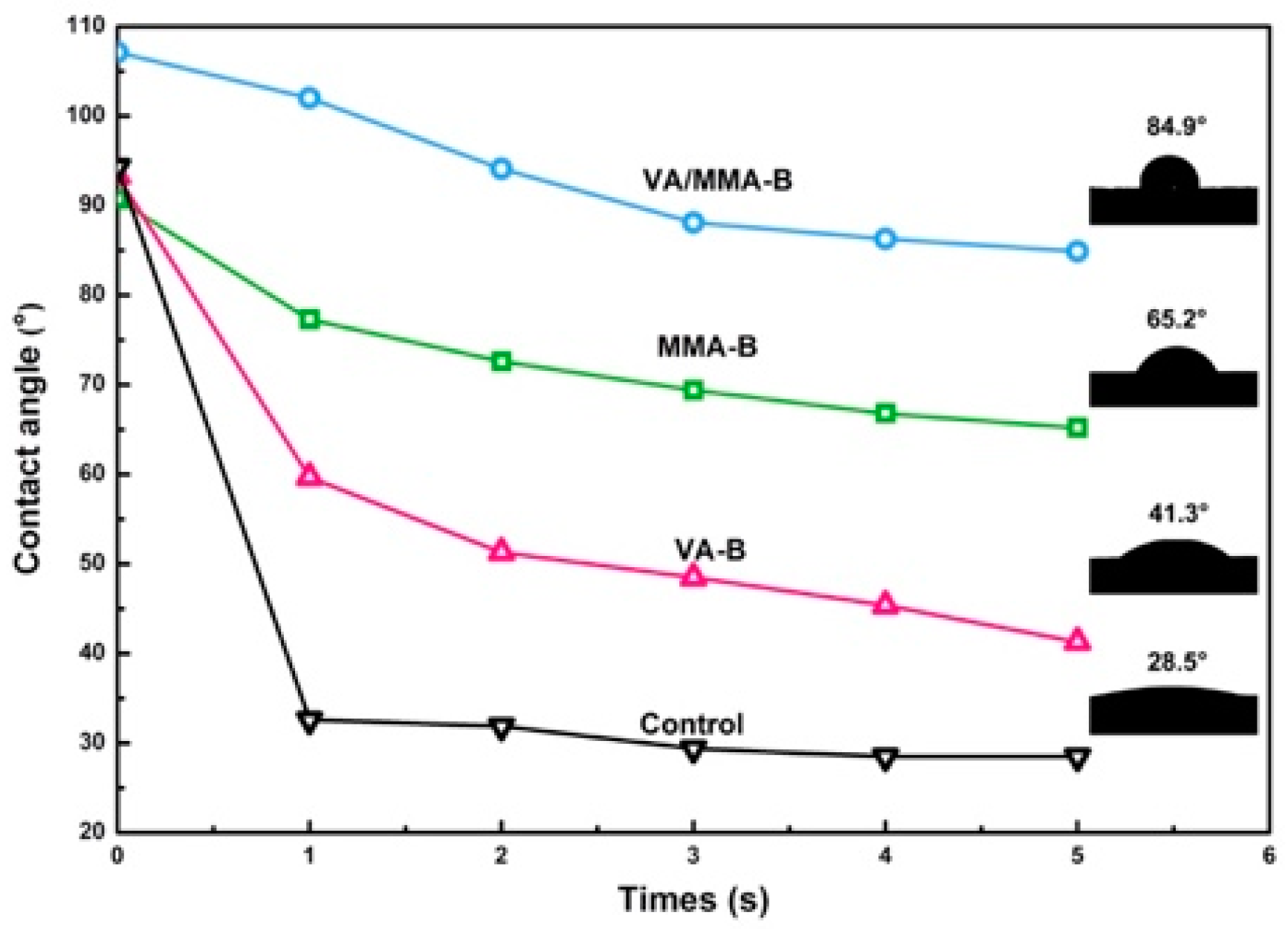
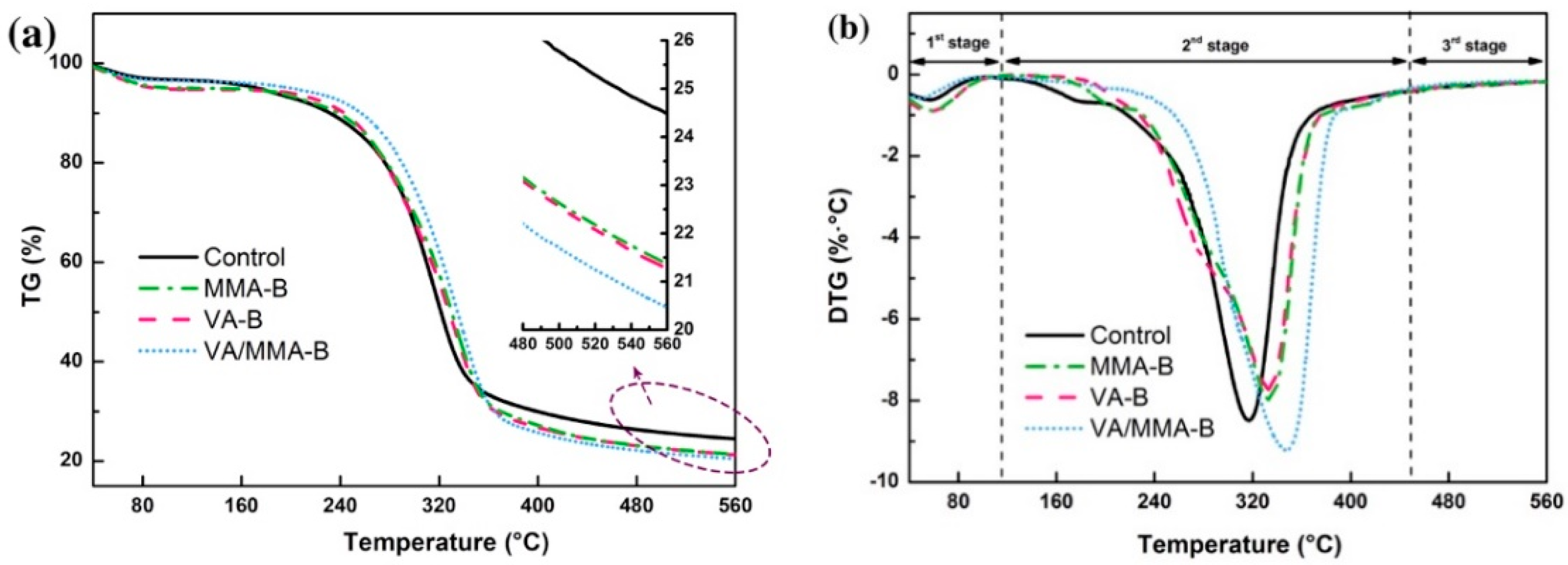
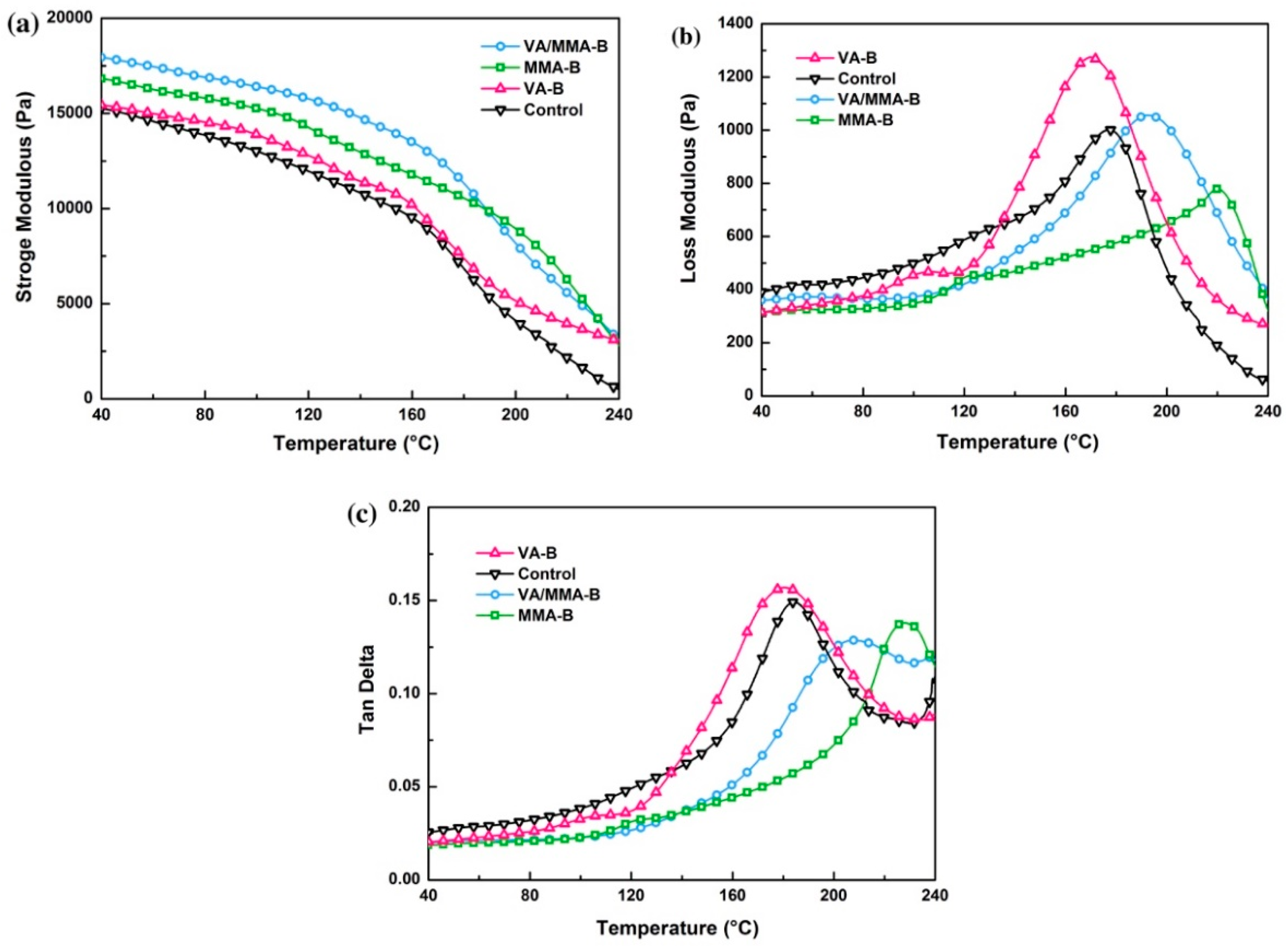
| Samples | Weight Percentage Gain (%) | Volume Bulking Efficiency (%) | Conversion Rate (%) |
|---|---|---|---|
| VA-B | 11.09 ± 0.56 | 4.25 ± 0.21 | / |
| MMA-B | 6.59 ± 0.33 | 3.49 ± 0.17 | 8.68 ± 0.43 |
| VA/MMA-B | 18.95 ± 0.95 | 8.66 ± 0.43 | 20.69 ± 1.03 |
| Wavenumber/(cm−1) | Assignment | Peak Height of Associated Bands | |||
|---|---|---|---|---|---|
| Control | VA/MMA-B | VA-B | MMA-B | ||
| 1740 | C=O stretching vibration | 0.195 | 0.766 | 0.494 | 0.323 |
| 1660 | H–O–H deformation vibration and conjugated C=O stretching vibration | 0.159 | 0.486 | 0.440 | 0.164 |
| 1506 | Aromatic skeletal | 0.171 | 0.446 | 0.377 | 0.171 |
| 1460 | C–H deformation (asymmetric) and benzene vibration in lignin | 0.190 | 0.421 | 0.457 | 0.176 |
| 1422 | C–H deformation (asymmetric) | 0.189 | 0.457 | 0.457 | 0.189 |
| 1370 | C–H2 deformation (symmetric) | 0.454 | 0.530 | 0.229 | 0.187 |
| 1240 | C–O stretching vibration in lignin, acetyl and carboxylic vibration in xylan | 0.180 | 0.587 | 0.470 | 0.248 |
| 1056 | C–O stretching | 0.177 | 0.526 | 0.472 | 0.231 |
| 899 | C1 group frequency in cellulose and hemicellulose | 0.077 | 0.216 | 0.132 | 0.065 |
© 2019 by the authors. Licensee MDPI, Basel, Switzerland. This article is an open access article distributed under the terms and conditions of the Creative Commons Attribution (CC BY) license (http://creativecommons.org/licenses/by/4.0/).
Share and Cite
Huang, S.; Jiang, Q.; Yu, B.; Nie, Y.; Ma, Z.; Ma, L. Combined Chemical Modification of Bamboo Material Prepared Using Vinyl Acetate and Methyl Methacrylate: Dimensional Stability, Chemical Structure, and Dynamic Mechanical Properties. Polymers 2019, 11, 1651. https://doi.org/10.3390/polym11101651
Huang S, Jiang Q, Yu B, Nie Y, Ma Z, Ma L. Combined Chemical Modification of Bamboo Material Prepared Using Vinyl Acetate and Methyl Methacrylate: Dimensional Stability, Chemical Structure, and Dynamic Mechanical Properties. Polymers. 2019; 11(10):1651. https://doi.org/10.3390/polym11101651
Chicago/Turabian StyleHuang, Saisai, Qiufang Jiang, Bin Yu, Yujing Nie, Zhongqing Ma, and Lingfei Ma. 2019. "Combined Chemical Modification of Bamboo Material Prepared Using Vinyl Acetate and Methyl Methacrylate: Dimensional Stability, Chemical Structure, and Dynamic Mechanical Properties" Polymers 11, no. 10: 1651. https://doi.org/10.3390/polym11101651
APA StyleHuang, S., Jiang, Q., Yu, B., Nie, Y., Ma, Z., & Ma, L. (2019). Combined Chemical Modification of Bamboo Material Prepared Using Vinyl Acetate and Methyl Methacrylate: Dimensional Stability, Chemical Structure, and Dynamic Mechanical Properties. Polymers, 11(10), 1651. https://doi.org/10.3390/polym11101651






